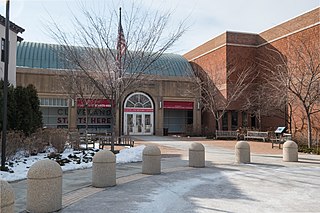
The Western Reserve Historical Society (WRHS) is a historical society in Cleveland, Ohio. The society operates the Cleveland History Center, a collection of museums in University Circle.

Walker and Weeks was an architecture firm based in Cleveland, Ohio, founded by Frank Ray Walker and Harry E. Weeks.
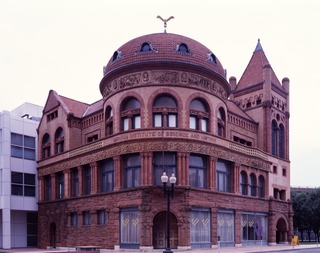
The Barnum Museum is a museum at 820 Main Street in Bridgeport, Connecticut, United States. It has an extensive collection related to P. T. Barnum and the history of Bridgeport, and is housed in a historic building on the National Register of Historic Places.
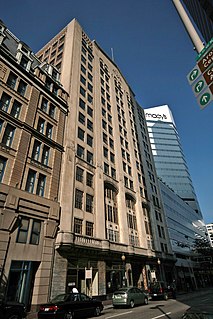
The Cincinnati Enquirer Building is the former headquarters building of The Cincinnati Enquirer on Vine Street in downtown Cincinnati, Ohio. It was designed by the firm of Lockwood Greene and Company and completed in 1926. The newspaper had been published from premises on the same site since 1866.

The A.M. Detmer House is a historic residence in Cincinnati, Ohio, United States. Constructed in the 1880s, it has been named a historic site as an example of the work of a prominent architect.

The Walter Field House is a historic residence located along Reading Road in northern Cincinnati, Ohio, United States. Built in the 1880s to be the home of a prosperous local businessman, it features elements of popular late-nineteenth-century architectural styles, and it was produced by one of the city's leading architects. It has been named a historic site.
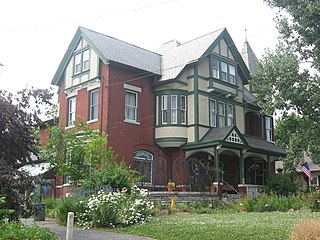
The George Scott House is a historic residence in Cincinnati, Ohio, United States. Built in the 1880s according to a design by prominent architect Samuel Hannaford, it was originally home to a prosperous businessman, and it has been named a historic site.

Old North Columbus is a neighborhood located just north of the Ohio State University in Columbus, Ohio. It was founded in 1847 where, at the time, it was a stand-alone city out of the confines of Columbus until it was incorporated into the City of Columbus in 1871. In its early years the city was a popular stagecoach stop with people traveling from Worthington to Columbus. Today Old North Columbus is popular for its local music and its unique "untouched architecture" which is reminiscent of its old roots.

The Cuyahoga County Courthouse stretches along Lakeside Avenue at the north end of the Cleveland Mall in downtown Cleveland, Ohio. The building was listed on the National Register along with the mall district in 1975. Other notable buildings of the Group Plan are the Howard M. Metzenbaum U.S. Courthouse designed by Arnold Brunner, the Cleveland Public Library, the Board of Education Building, Cleveland City Hall, and Public Auditorium.

The Coshocton County Courthouse, designed in Second Empire style, is a historic courthouse building located at 349 Main Street in Coshocton, Ohio. It was added to the National Register of Historic Places on 1973-05-22.

Charles Scribner's Sons Building is a building at 597 Fifth Avenue in Midtown Manhattan, New York City. Designed by Ernest Flagg in a Beaux Arts style, it was built in 1912–13 for the Scribner's Bookstore. Among its details are piers anchoring three large bays which include four medallions with busts of printers: Benjamin Franklin, William Caxton, Johann Gutenberg, and Aldus Manutius.
Coburn & Barnum was a Cleveland, Ohio architectural firm from 1878 to 1897. It was established by Forrest A. Coburn and Frank Seymour Barnum. The firm also included W. Dominick Benes and Benjamin S. Hubbell for one year and was known as Coburn, Barnum, Benes & Hubbell until 1897, when Benes and Hubell departed to establish their own firm Hubbell & Benes. After their departure and Coburn's death, Barnum formed F. S. Barnum & Co. with Albert Skeel, Harry S. Nelson, Herbert Briggs, and Wilbur M. Hall. Barnum also served as consulting architect to the Cleveland Board of Education. He retired in 1915 having designed more than 75 school buildings, the Caxton Building (1903) and the Park Building (1904), an early example of reinforced concrete floor slabs. The firm continued after his 1915 retirement under the name of Briggs & Nelson.

Bullock's Pasadena, in Pasadena, California, is a 240,000-square foot (21 368 m²) Streamline Moderne Art Deco architectural style building. Built in 1947, it is listed on the National Register of Historic Places.

Wheeling Historic District, also known as the Wheeling Central Business District, is a national historic district located at Wheeling, Ohio County, West Virginia. The district includes 205 contributing buildings in the central business district of Wheeling. It includes the site of the original location of Fort Henry. The buildings are representative of a number of popular architectural styles from the early-19th century through the present including Greek Revival and Late Victorian. The District was listed on the National Register of Historic Places in 1979.

Hubbell & Benes was a prominent Cleveland, Ohio architectural firm formed by Benjamin Hubbell (1857–1935) and W. Dominick Benes (1867–1953) in 1897 after the pair departed from Coburn, Barnum, Benes & Hubbell. Their work included commercial and residential buildings as well as telephone exchange buildings, the West Side Market and Cleveland Museum of Art. Before teaming up they worked for Coburn and Barnum. Benes was Jeptha Wade’s personal architect and designed numerous public buildings, commercial buildings, and residences for him including the Wade Memorial Chapel.

The Park Building is a historic commercial building on Public Square in downtown Cleveland, Ohio, United States. It was named a historic site in 1996.
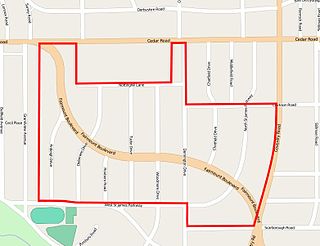
The Euclid Golf Allotment, also known as the Euclid Golf Historic District, is a historic district located in Cleveland Heights, Ohio, in the United States. Roughly bounded by Cedar Road, Coventry Road, West St. James Parkway, and Ardleigh Drive, the 142-acre (0.57 km2) site contains primarily residential homes built between 1913 and 1929. The historic district is built on land formerly owned by John D. Rockefeller and at one time leased to the Euclid Golf Club for its back nine holes, and it takes its name from this historic factoid. The Euclid Golf Allotment is a largely undisturbed example of an early 20th century planned community containing American Craftsman, Colonial Revival, French Renaissance Revival, Italian Renaissance Revival, Prairie School, Shingle Style, and Tudor Revival architecture.
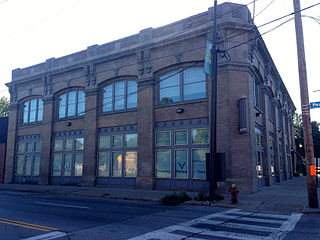
The Brooklyn Bank Building is a historic bank structure located in Cleveland, Ohio, in the United States. Designed in 1904 by noted Cleveland architect J. Milton Dyer as a home for the Brooklyn Savings and Loan Association, the building exhibits a mix of architectural styles, including Neoclassical and Commercial, typical of Dyer's eclectic work.

The Brownell School and Annex are three historic former public school buildings located on Sumner Street in Cleveland, Ohio, in the United States. The Queen Anne-style main building was designed by prominent local architect John Eisenmann, and erected from 1884 to 1885. The first annex was designed by noted local architect Frank Seymour Barnum, and completed in 1905. The second annex, also by Barnum, was finished in 1909. Several individuals of local and national importance were educated there or taught school there, and the building served as the first campus of Cuyahoga Community College in 1962. The building was sold to private owners in 1979, and the complex underwent a major renovation from 1983 to 1985.
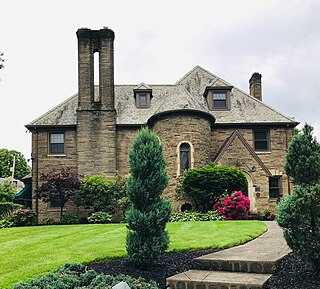
The Ridgewood Historic District is a residential neighborhood in Canton, Ohio. The neighborhood consists of preserved, architect-designed Revival style buildings built in the early 20th century with amenities such as original brick streets and locally produced street lighting standards. The District features homes designed by several distinguished architects, including Charles Firestone, Herman Albrecht, and Louis Hoicowitz. Due to its historic architectural significance, the District was added to the U.S. National Register of Historic Places on December 19, 1982.





















